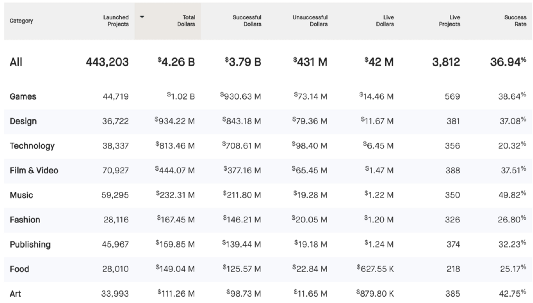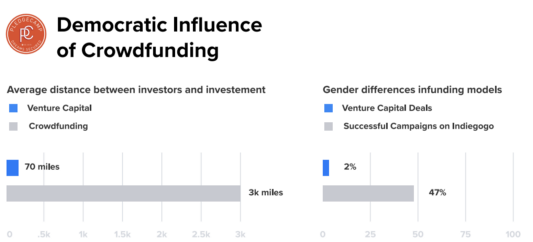After Kickstarter: Crowdfunding 2.0

The current leader in crowdfunding turns 10 years old today — here’s why the next decade may see a new leader.
Today, Kickstarter CEO Aziz Hasan posted a congratulatory blog post celebrating the platform’s 10th birthday. Rightfully so, he celebrated Kickstarter’s incredible achievements of:
160,000 projects funded
$4.2 Billion dollars raised
16 million backers.
These incredible numbers show how impactful the crowdfunding industry has become over the years. There is every reason to be optimistic for the future of crowdfunding. Take it from Goldman Sachs:
We estimate crowdfunding could address a $1.2 trillion opportunity over time.” Goldman Sachs Research; The Future of Finance (2015)
Crowdfunding is the future.
Kickstarter’s Limited Approach
In reading the article, we noticed many details that confirmed a truth that we — and many industry insiders — have understood for a long time.
Their CEO begins with their mission: “to help bring creative projects to life.” (emphasis added) He laments that, “Artists still struggle to make ends meet.” He mentions government funding for the arts and the filmmaking industry — but never technology or entrepreneurship.
But as we will see in the next section, entrepreneurship is the biggest driver and draw for users on the platform.
The evidence seems clear to us, from their own words and real-world product decisions, that Kickstarter puts their philosophy of supporting the arts above the demonstrated needs of their users.
Money Speaks
The Kickstarter 10th anniversary post does not mention that the platform, based on a 5% fee on successful dollars, has earned presumably $190 million dollars in listing fees, coming primarily from the Games, Design, and Technology categories.
These categories primarily pre-sell consumer products like tabletop board games, textiles such as backpacks, shoes, and jackets, and new technology gadgets.

**Creative art may be Kickstarter’s philosophical priority, but the dollars prove what their users want. Source: https://www.kickstarter.com/help/stats
In total dollars, these three generally non-artistic product categories make up about twice the revenue of all the other categories combined
They fail to mention that their first million-dollar-project was an iPhone dock, and that their biggest campaigns are mostly tech products (such as the Coolest Cooler, a $13.2 million-dollar campaign that became one of Kickstarter’s biggest cautionary tales).
Art may be where their heart is, but the reality is that their users want crowdfunding to produce products.
So What?
We have nothing against creative projects, or supporting the arts. We are fully supportive of this endeavor.
However, when users clearly want to use the platform for funding products but the platform doesn’t prioritize their needs, conflicts will inevitably arise.
Namely, Kickstarter offers no protection for backers who are supporting these risky tech products, even while actively promoting these campaigns on their website, and taking a 5% listing fee of all funds raised, even if the project ultimately fails.
The following is official policy from their Terms of Use:
Kickstarter doesn’t offer refunds. Responsibility for finishing a project lies entirely with the project creator. Kickstarter doesn’t hold funds on creators’ behalf, cannot guarantee creators’ work, and does not offer refunds.
and,
We don’t oversee projects’ performance, and we don’t mediate disputes between users…
We don’t oversee the performance or punctuality of projects, and we don’t endorse any content users submit to the Site…
You’re solely responsible for any resulting damage or loss to any party.
(read the whole thing here: https://www.kickstarter.com/terms-of-use)
Backers Alone Feel the Repercussions
To put it simply, backers are left to fend for themselves with no security mechanisms provided by the platform, and no guarantees enforced from the creators. And when the rules are stacked against backers so harshly, the outcomes are predictable.
According to a study by Wharton professor Ethan Mollick, 85% of campaigns delay while up to 14% under-deliver, or fail to deliver anything at all. And from stats available on Kickstarter’s own website, less than 1/3 of Kickstarter backers have supported a second campaign.

Source: https://www.kickstarter.com/help/stats
This is a direct result of the stance that Kickstarter has taken and the design of its features. Kickstarter may have noble intentions, but the ecosystem they enabled is undeniably harming users.
In our view, this media interview with Perry Chen (the second Kickstarter CEO to depart in the last two years) unintentionally gives the company a perfect nickname in the headline:
“Idealism, Inc.”
Now, it’s time for a practical solution.
Crowdfunding Deserves a Better Future
In order for crowdfunding to reach its true potential, the reality of how users want to use it must be addressed and served by the platform.
Not only can doing so unlock the “trillion dollar opportunity” as Goldman Sachs predicted, but it can be a powerful force for socio-economic good as well.
Crowdfunding allows any entrepreneur raise funds directly from their biggest supporters and target market — unlocking opportunities for anyone, and not just those who have elite connections or access to Silicon Valley.

Courtesy: https://pledgecamp.com/whitepaper
The World Bank estimates that 344 million households in the developing world could contribute an additional $96 billion per year to crowdfunding, led by China, East Asia, Central Europe, Latin America/the Caribbean, and the MENA region. [1] According to their report, this number would represent 1.8 times the volume of venture capital investments.
In addition, as you can see in the graphic above, crowdfunding challenges geographic limitations and gender barriers in funding as well.
Crowdfunding opens entrepreneurship to the entire world — women, minorities , those born in traditionally overlooked regions — and ultimately extends opportunity to anyone worthy in the court of public opinion.
Now that is an idealistic future we can get behind.
This post was brought to you by the Pledgecamp, a next-generation crowdfunding platform that is addressing longstanding issues of trust and accountability in the industry. Backed by Randi Zuckerberg and designed by the UX/UI firm behind Slack, Coinbase, and others, Pledgecamp aims to launch by Q4 of 2019.
Learn more at our website and visit our Telegram community today.
[1] InfoDev, World Bank, Finance and Private Sector Development Department. “Crowdfunding’s Potential for the Developing World, 2012, Foreword. www.infodev.org/infodevfiles/wb_crowdfundingreport-v12.pdf
Congratulations @ethbull! You have completed the following achievement on the Steem blockchain and have been rewarded with new badge(s) :
You can view your badges on your Steem Board and compare to others on the Steem Ranking
If you no longer want to receive notifications, reply to this comment with the word
STOPDo not miss the last post from @steemitboard:
Vote for @Steemitboard as a witness to get one more award and increased upvotes!
Congratulations @ethbull! You received a personal award!
You can view your badges on your Steem Board and compare to others on the Steem Ranking
Do not miss the last post from @steemitboard:
Vote for @Steemitboard as a witness to get one more award and increased upvotes!